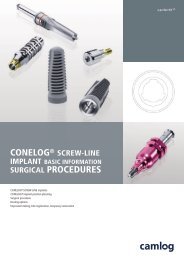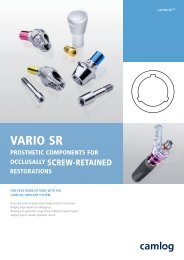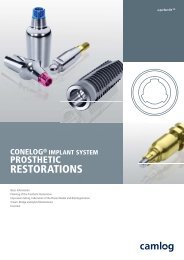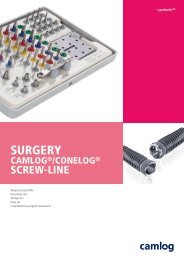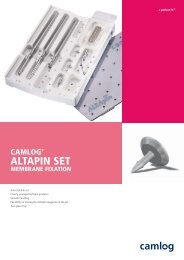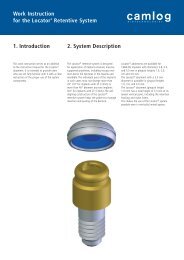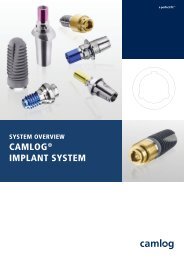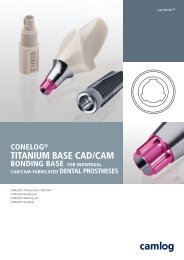Hybrid Restorations with the CAMLOG Implant System (PDF
Hybrid Restorations with the CAMLOG Implant System (PDF
Hybrid Restorations with the CAMLOG Implant System (PDF
You also want an ePaper? Increase the reach of your titles
YUMPU automatically turns print PDFs into web optimized ePapers that Google loves.
INVESTMENT, CAST AND DEVESTMENT<br />
The abutment is embedded according to <strong>the</strong> instruction manual of <strong>the</strong> muffle<br />
system used. We do not recommend <strong>the</strong> use of a wax wetting agent.<br />
However, if wax wetting agents are used, it must be suitable for use <strong>with</strong><br />
POM plastic components. When embedding, <strong>the</strong> correct placement of <strong>the</strong><br />
wax-up in <strong>the</strong> casting muffle is of importance. Volume ratios and pin angles<br />
must be selected so that <strong>the</strong> required temperature for casting is<br />
achieved. This is particularly important for voluminous casts. We recommend<br />
phosphate bound investment materials. The manufacturer's processing<br />
instructions must be observed and <strong>the</strong> mixing ratios and preheating<br />
times accurately observed. We recommend you do not use any quick heating<br />
processes (speed investment materials). The cast delay time must be<br />
kept as brief as possible.<br />
After casting, <strong>the</strong> cast object must be slowly cooled to room temperature<br />
and <strong>the</strong> object gently devested. We recommend gentle devestment in an<br />
ultrasonic bath <strong>with</strong> waterjet or stripping.<br />
After casting, suitable reworking reamers are available to remove/smooth<br />
out casting residues for reworking <strong>the</strong> screw seat and <strong>the</strong> shoulder contact<br />
area to <strong>the</strong> <strong>CAMLOG</strong> ® bar abutment.<br />
After trimming <strong>the</strong> bar, it is checked for a precision fit. Good hygiene capacity<br />
must be ensured. A distance of min. 2 mm to <strong>the</strong> gingiva must be maintained<br />
to prevent insufficient cleaning and associated changes to <strong>the</strong> mucous<br />
membrane.<br />
The secondary framework, e.g. electroplating technique, is <strong>the</strong>n fabricated.<br />
Reworking reamer,<br />
for base for bar abutment,<br />
for <strong>the</strong> screw seat<br />
Ø 3.3/3.8/4.3 mm and 5.0/6.0 mm<br />
Reworking reamer, for base<br />
for bar abutment, for<br />
<strong>the</strong> plane surface/cone seat<br />
Ø 3.3/3.8/4.3 mm and 5.0/6.0 mm<br />
Example: Milled bar construction<br />
Example: Milled bar construction <strong>with</strong><br />
secondary framework using <strong>the</strong> electroplating<br />
technique and tertiary structure<br />
HYBRID RESTORATIONS WITH THE <strong>CAMLOG</strong> ® IMPLANT SYSTEM<br />
Cast bar<br />
Cast bar<br />
base<br />
Cast bar<br />
Cast bar<br />
base<br />
Reaming out <strong>the</strong> screw channel<br />
of <strong>the</strong> cast bar base<br />
Reaming out <strong>the</strong> inner cone and plane<br />
surface of <strong>the</strong> cast bar base<br />
29




